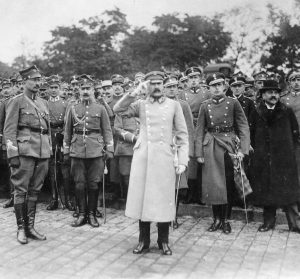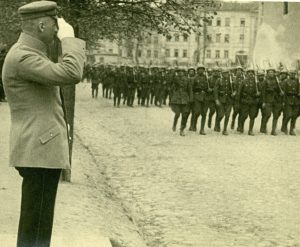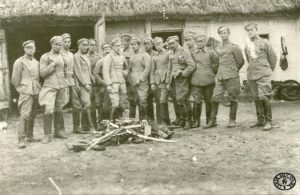Hundreds of thousands of Polish soldiers incorporated into the armies of the partitioning powers fought on First World War fronts for political and military goals that were not their own. Cohesive military formations of Polish volunteers — the most well known being the Polish Legions deployed alongside the Austro-Hungarian army, the Polish Corps created in Russia after the revolution in February 1917 and the Polish Army in France (also known as General Józef Haller’s Army) — were an outward expression of Poles’ aspiration for a free Polish state with national armed forces. The Polish Military Organisation was also preparing to fight for an independent Poland as it carried out its illegal and legal but illicit activities in Poland. Poland’s participation in military action during the war was one of the most relevant arguments for supporting its independence in the post-war world.

On 5 November 1916 the Germans and Austro-Hungary announced they would formally establish an independent Kingdom of Poland with its own army that would be under the control of the German command headquarters during the war. The Polish Legions were supposed to form the core of this army so on 10 April 1917 they were transferred to the Germans who started to set up the Polnische Wehrmacht. The soldiers from the Polish Legions were supposed to take an oath in July 1917 which included swearing allegiance to the German allies. Influenced by Józef Piłsudski the vast majority of the soldiers asked to do so refused to take the oath and were interned as a consequence. Piłsudski was interned by the Germans for instigating this mass refusal to take the oath.
The German Governor-General was left with a very modest Polnische Wehrmacht under his command which consisted only of the soldiers who had taken the oath (101 officers and 1,125 non-commissioned officers and privates as at the end of August 1917). In the summer and autumn of 1918 when the military position pointed towards inevitable defeat in the war for the Central Powers, the Regency Council, a body appointed at the behest of the Germans as a substitute for a Polish supreme state authority, issued a decree on 12 October 1918 announcing that the Polnische Wehrmacht was under its command and the army oath wording would reflect this. In reality the Polish army units were still answerable to the German authorities, but even so the growth in numbers volunteering to join this formation was noticeable. On 26 October 1918 the Military Commission was turned into the Ministry for Military Affairs and to make a point Piłsudski, who was imprisoned in Magdeburg Fortress by the Germans at the time, was appointed as its head. The Polnische Wehrmacht was being turned into the Polish Army.

On 10 November 1918 Józef Piłsudski arrived in Warsaw. At this point the occupying German army was already falling apart, particularly in the capital where the Polish Military Organisation had started to disarm the Germans. The first success story for the re-emerging Polish state and Piłsudski’s emerging power was the agreement with the German Military Council regarding the evacuation of the German army units, amounting to approximately 80,000 soldiers. By the 19 November they had departed from the whole of the Kingdom of Poland except the Suwalszczyzna area and parts of the Podlasie area. The Germans left their fixtures and fittings and military equipment behind; at the border they parted with their weapons.
On 11 November 1918 the Regency Council transferred command of the Polish Army, the national armed forces, to Józef Piłsudski. Then on 14 November it ceded all its power to him. On receiving the news that Piłsudski had returned to Poland the remaining Polish political groupings (in Cieszyn, Kraków and Lublin) which had come into existence in order to set up an independent state and had also created embryonic armed formations, submitted to his authority.
Piłsudski considered the army to be the driving force behind nation-building. In the initial weeks and months of independence the army was in the process of being formed and at the same time soldiers who were not yet fully trained or fitted out in uniforms were being sent off to the front. This was necessary because: from November 1918 onwards heavy battles were being waged with the Ukrainians in Galicia; in January 1919 the Polish–Czech discord over Cieszyn Silesia turned into armed conflict; and in February 1919 the first clashes with Bolshevik Russia’s soldiers occurred.
As the Commander-in-Chief Józef Piłsudski was confronted with the issue of integration within the Polish Army. It was a hotchpotch cobbled together from constituent parts which originated from the Polish Legions, the Polish Military Organisation, the Polnische Wehrmacht created by the German occupying forces, the Polish military units set up in Russia, the Austro-Hungarian army and the Russian army. The main body of soldiers was initially formed from volunteers (around 56,000 by March 1919) and then from recruits following legislation on conscription passed by the parliament in March, so by April the army numbered 200,000 soldiers. From April 1919 onwards the men of the Polish Army in France started returning to Poland; this army commanded by General Józef Haller consisted of more than 80,000 very well equipped and well trained soldiers.

Wielkopolska which was liberated as a result of a successful uprising in 1918–1919 was creating its own army, which was about 60,000 strong. This army did not officially report to the national High Command. Wielkopolska’s army did not merge with the rest of the Polish Army until 1 August 1919, after the Treaty of Versailles was signed. It also took quite some time to merge the Polish units established in France (Haller’s Army) with the Polish Army. On 19 October 1919 a celebration of the completion of the unification of the Polish armies took place in Kraków in the presence of Józef Piłsudski, General Józef Haller and General Józef Dowbor-Muśnicki, the commander of what was previously Wielkopolska’s army.
The Commander-in-Chief took into account the importance of military symbolism in merging the various formations into a single unified army. The reintroduction of the Virtuti Militari order, a historic Polish military decoration, was of particular importance in this respect. This order, one of the oldest honours of its kind in Europe, was established by King Stanisław August Poniatowski in 1792 to celebrate victory in the Battle of Zieleńce during the Polish-Lithuanian Commonwealth’s war against Russia in defence of the Third of May Constitution.
| Monument of Józef Piłsudski in Ostrów Mazowiecka |


